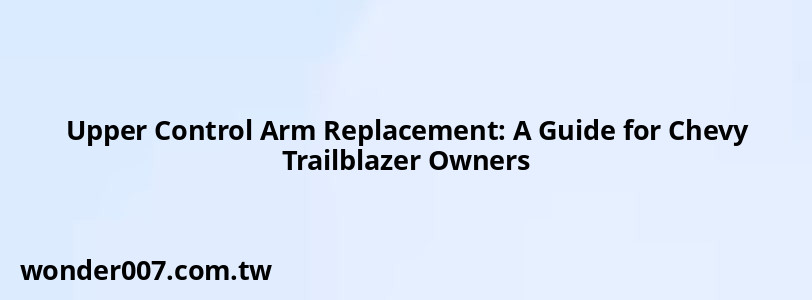Upper Control Arm Replacement: A Guide for Chevy Trailblazer Owners

Replacing the upper control arm on your Chevy Trailblazer is a vital maintenance task that ensures your vehicle's suspension system functions properly. This guide will provide you with a detailed overview of the replacement process, tools required, and important tips to ensure a successful installation.
Understanding the Upper Control Arm
The upper control arm is a crucial component of your vehicle's suspension system. It connects the vehicle's frame to the wheel hub and allows for vertical movement while maintaining proper wheel alignment. Over time, wear and tear can lead to issues such as poor handling, uneven tire wear, and noise during driving.
Tools and Materials Needed
Before starting the replacement process, gather the following tools and materials:
- Hydraulic jack and jack stands
- Lug nut wrench
- Socket set (including 10mm, 19mm, and 21mm sockets)
- Torque wrench
- Ball joint separator
- Penetrating oil (for rusted bolts)
- Replacement upper control arm
- Safety goggles and gloves
Step-by-Step Replacement Process
1. Prepare the Vehicle
Ensure your vehicle is parked on a flat surface with the parking brake engaged. Loosen the lug nuts on the front wheels but do not remove them yet.
2. Lift the Vehicle
Using a hydraulic jack, lift the front of your Trailblazer until it is high enough to place jack stands securely under the frame. Once secure, remove the front wheels.
3. Remove Obstructing Components
Depending on your model year, you may need to remove additional components such as:
- Brake calipers
- Sway bar links
- Any other suspension parts blocking access to the upper control arm
4. Detach the Ball Joint
Use a ball joint separator to detach the ball joint from the upper control arm. This may require some force; apply penetrating oil if necessary to loosen rusted connections.
5. Remove Control Arm Bolts
Locate and remove the bolts securing the upper control arm to both the frame and the knuckle using your socket set. Be cautious, as these bolts may be seized.
6. Remove Old Control Arm
Once all bolts are removed, take out the old upper control arm from its position. Inspect surrounding components for wear or damage.
7. Install New Control Arm
Position the new upper control arm in place, ensuring it is oriented correctly compared to the old one. Secure it with bolts but do not fully tighten them yet.
8. Reattach Ball Joint
Reconnect the ball joint to the knuckle and secure it with its nut. Ensure everything is aligned correctly before tightening.
9. Torque All Fasteners
Using a torque wrench, tighten all bolts to their specified torque settings as per your vehicle's service manual.
10. Reassemble Components
Reinstall any components you removed earlier, such as brake calipers or sway bar links.
11. Reinstall Wheels
Place the wheels back on and hand-tighten the lug nuts before lowering the vehicle back to ground level.
12. Final Torque Check
Once on the ground, use your torque wrench to tighten all lug nuts in a crisscross pattern to ensure even pressure.
Important Tips
- Alignment: After replacing your upper control arm, an alignment is highly recommended to ensure proper handling and tire wear.
- Safety First: Always prioritize safety by wearing gloves and goggles during this process.
- Consult Your Manual: Refer to your vehicle’s service manual for specific torque specifications and detailed diagrams of suspension components.
FAQs About Upper Control Arm Replacement
- How often should I replace my upper control arms?
Typically every 50,000 to 100,000 miles or when you notice signs of wear. - Can I replace just one upper control arm?
While it's possible, it's often recommended to replace both sides for balanced handling. - What are signs of a failing upper control arm?
Common signs include clunking noises, uneven tire wear, and poor steering response.
Related Posts
-
Stiff Brake Pedal and Car Won't Start: Troubleshooting Guide
29-01-2025 • 211 views -
Chevy Cruze: Intake Air Temperature Sensor Location Guide
28-01-2025 • 305 views -
2006 Hyundai Tucson Serpentine Belt Routing Guide
27-01-2025 • 146 views -
Toyota Throttle Position Sensor Wiring Diagram: A Comprehensive Guide
29-01-2025 • 243 views -
Air Conditioner Compressor for 2001 Chevy Suburban: A Complete Guide
30-01-2025 • 161 views
Latest Posts
-
Rear Brake Caliper Piston Won't Compress
01-02-2025 • 356 views -
2015 Chevy Traverse AC Recharge Port Location
01-02-2025 • 409 views -
Power Steering Fluid Leak On Passenger Side
01-02-2025 • 457 views -
How To Turn Off Paddle Shifters Mercedes
01-02-2025 • 377 views -
Are O2 Sensors Covered Under Warranty
01-02-2025 • 376 views
Popular Posts
-
V12 Engine Costs: What You Need to Know
26-01-2025 • 679 views -
Power Steering and ABS Light On: Causes and Solutions
27-01-2025 • 643 views -
EPC Light: Understanding Causes and Solutions
26-01-2025 • 1053 views -
EPC Warning Light: What It Means for Your Vehicle
27-01-2025 • 630 views -
Hino Warning Lights: Understanding Dashboard Alerts
26-01-2025 • 765 views
